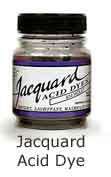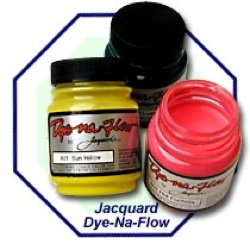dyeing a fishing vest so that it will not scare the fish
Name: Wendell
Message: Dear Paula,
I have a fishing vest that is light tan and has a 100% nylon shell. A stretchy mesh section made of 70% nylon and 30% spandex covers the shoulders. I just want to dye it a darker color -- either brown or a dark olive.
The reason for this color change is because trout can see light colors even at a distance and this causes them to take cover and hide. The vest manufacturers only offer light colors except for a few, and even those are not dark enough. I am an underwater videographer and my research has proven this out. Many anglers ask me how they can dye them (they are expensive.....from $50 to $140) and that is why I searched the internet and found your site. I hope it will not be a complicated operation.
There are two different options to consider here: acid dyes versus fabric paints.
You can dye nylon, but there's a problem here to be aware of. Nylon requires heat to dye well, but spandex is extremely heat sensitive. I don't know how permanent the dye will be if you stick to temperatures that are low enough not to endanger the set of the spandex, and yet I am afraid that heat about 105°F may cause the spandex to lose its shape. What do the care instructions say about washing? Do they say to use cool water only?
See my page on "How to Dye Spandex". Here also is a link to a discussion of the different dyes you can use to dye nylon, posted in this blog on November 9, 2007.

Typical instructions for dyeing nylon call for gradually heating the fabric in a large cooking pot of dye dissolved in water, with an acid such as vinegar to adjust the pH, slowly raising the temperature to 205°F (96°C), and then holding the dyebath at that temperature for half an hour to an hour, after which the dyebath is allowed to cool to room temperature, and then the dyed garment is washed out. For example, see ProChem's instructions for dyeing with their Washfast Acid line of dyes. To dye a nylon/spandex garment, you will need to use a much lower temperature to avoid damaging the spandex. The spandex will not melt, and in fact may itself be dyed at 140°F, but any shape that was set into your spandex fabric at the time of manufacture will be reset by high heat.
 There is a safer alternative, another way to darken your vest so that it will
not alert the trout. Instead of using dye, you can use fabric paint
or pigment dyeing. Fabric paints and pigment dyes use an acrylic binder, instead
of a chemical interaction between dye and fiber, to hold the tiny particles of
pigment onto the fabric. You cannot get a smooth, perfect, even shade throughout
the garment, but instead a somewhat mottled effect, such as you see in
commercially pigment-dyed clothing. However, it seems as though a mottled effect
might actually be superior for your purposes, as compared to a smooth solid
color.
There is a safer alternative, another way to darken your vest so that it will
not alert the trout. Instead of using dye, you can use fabric paint
or pigment dyeing. Fabric paints and pigment dyes use an acrylic binder, instead
of a chemical interaction between dye and fiber, to hold the tiny particles of
pigment onto the fabric. You cannot get a smooth, perfect, even shade throughout
the garment, but instead a somewhat mottled effect, such as you see in
commercially pigment-dyed clothing. However, it seems as though a mottled effect
might actually be superior for your purposes, as compared to a smooth solid
color.
Some fabric paints require heat-setting, but less extensive exposure to heat than you would give it in a dyebath; others can be set by adding a chemical catalyst to the fabric paint, and some do not require any heat-setting at all. For example, Dharma Pigment Dye is supposed to be set for a few minutes in a hot dryer. (Let the paint dry thoroughly before putting it in the dryer.) Dye-na-flow, a thin, flowable paint made by Jacquard Products, can be diluted with up to 25% water; an additive that can be purchased separately, Jacquard Airfix, makes heat-setting unnecessary.
None of
these suggestions will work if the fabric has been treated in any way to make it
stain-resistant or water-repellent. Even a permanent-press finish can cause
problems with both fabric dyes and fabric paints. Surface finishes will repel
both the dyebath and the fabric paint. Try sprinkling water on the garment: if
it beads up, you will not be able to change the color of the garment. If the
water soaks in, chances are good that you can do it, though not
certain.
of
these suggestions will work if the fabric has been treated in any way to make it
stain-resistant or water-repellent. Even a permanent-press finish can cause
problems with both fabric dyes and fabric paints. Surface finishes will repel
both the dyebath and the fabric paint. Try sprinkling water on the garment: if
it beads up, you will not be able to change the color of the garment. If the
water soaks in, chances are good that you can do it, though not
certain.
(Please help support this web site. Thank you.)
Message: Dear Paula,
I have a fishing vest that is light tan and has a 100% nylon shell. A stretchy mesh section made of 70% nylon and 30% spandex covers the shoulders. I just want to dye it a darker color -- either brown or a dark olive.
The reason for this color change is because trout can see light colors even at a distance and this causes them to take cover and hide. The vest manufacturers only offer light colors except for a few, and even those are not dark enough. I am an underwater videographer and my research has proven this out. Many anglers ask me how they can dye them (they are expensive.....from $50 to $140) and that is why I searched the internet and found your site. I hope it will not be a complicated operation.
There are two different options to consider here: acid dyes versus fabric paints.
You can dye nylon, but there's a problem here to be aware of. Nylon requires heat to dye well, but spandex is extremely heat sensitive. I don't know how permanent the dye will be if you stick to temperatures that are low enough not to endanger the set of the spandex, and yet I am afraid that heat about 105°F may cause the spandex to lose its shape. What do the care instructions say about washing? Do they say to use cool water only?
See my page on "How to Dye Spandex". Here also is a link to a discussion of the different dyes you can use to dye nylon, posted in this blog on November 9, 2007.

Typical instructions for dyeing nylon call for gradually heating the fabric in a large cooking pot of dye dissolved in water, with an acid such as vinegar to adjust the pH, slowly raising the temperature to 205°F (96°C), and then holding the dyebath at that temperature for half an hour to an hour, after which the dyebath is allowed to cool to room temperature, and then the dyed garment is washed out. For example, see ProChem's instructions for dyeing with their Washfast Acid line of dyes. To dye a nylon/spandex garment, you will need to use a much lower temperature to avoid damaging the spandex. The spandex will not melt, and in fact may itself be dyed at 140°F, but any shape that was set into your spandex fabric at the time of manufacture will be reset by high heat.
 There is a safer alternative, another way to darken your vest so that it will
not alert the trout. Instead of using dye, you can use fabric paint
or pigment dyeing. Fabric paints and pigment dyes use an acrylic binder, instead
of a chemical interaction between dye and fiber, to hold the tiny particles of
pigment onto the fabric. You cannot get a smooth, perfect, even shade throughout
the garment, but instead a somewhat mottled effect, such as you see in
commercially pigment-dyed clothing. However, it seems as though a mottled effect
might actually be superior for your purposes, as compared to a smooth solid
color.
There is a safer alternative, another way to darken your vest so that it will
not alert the trout. Instead of using dye, you can use fabric paint
or pigment dyeing. Fabric paints and pigment dyes use an acrylic binder, instead
of a chemical interaction between dye and fiber, to hold the tiny particles of
pigment onto the fabric. You cannot get a smooth, perfect, even shade throughout
the garment, but instead a somewhat mottled effect, such as you see in
commercially pigment-dyed clothing. However, it seems as though a mottled effect
might actually be superior for your purposes, as compared to a smooth solid
color.Some fabric paints require heat-setting, but less extensive exposure to heat than you would give it in a dyebath; others can be set by adding a chemical catalyst to the fabric paint, and some do not require any heat-setting at all. For example, Dharma Pigment Dye is supposed to be set for a few minutes in a hot dryer. (Let the paint dry thoroughly before putting it in the dryer.) Dye-na-flow, a thin, flowable paint made by Jacquard Products, can be diluted with up to 25% water; an additive that can be purchased separately, Jacquard Airfix, makes heat-setting unnecessary.
None
 of
these suggestions will work if the fabric has been treated in any way to make it
stain-resistant or water-repellent. Even a permanent-press finish can cause
problems with both fabric dyes and fabric paints. Surface finishes will repel
both the dyebath and the fabric paint. Try sprinkling water on the garment: if
it beads up, you will not be able to change the color of the garment. If the
water soaks in, chances are good that you can do it, though not
certain.
of
these suggestions will work if the fabric has been treated in any way to make it
stain-resistant or water-repellent. Even a permanent-press finish can cause
problems with both fabric dyes and fabric paints. Surface finishes will repel
both the dyebath and the fabric paint. Try sprinkling water on the garment: if
it beads up, you will not be able to change the color of the garment. If the
water soaks in, chances are good that you can do it, though not
certain.(Please help support this web site. Thank you.)
Posted: Sunday - November 18, 2007 at 08:43 AM
Follow this blog on twitter here.
Quick Links
- All About Dyes & Dyeing Top -
- Top of this blog -
- FAQ -
- The Dye Forum -
- How to Tie Dye - How to Batik -
- Books - Toys - Plants -
- Top of this blog -
- FAQ -
- The Dye Forum -
- How to Tie Dye - How to Batik -
- Books - Toys - Plants -
More in this category:
- -
Statistics
Total entries in this blog:
Total entries in this category:
Published On: Aug 29, 2012 02:48 PM
Total entries in this category:
Published On: Aug 29, 2012 02:48 PM